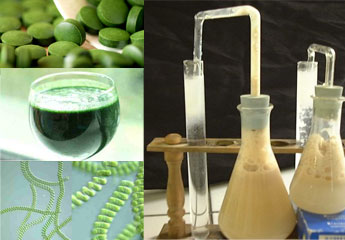The term single cell protein (SCP) refers to dried biomass or protein extracted from pure or mixed cultures of algae, yeasts, fungi or bacteria. These single cell protein can either be used as an ingredient for protein-rich foods suitable for human consumption or as an animal feed.

Why are single cell protein needed
The population of the world is increasing on an alarming rate side by side an increase demand in food production. This rapid increase in population in third world countries has led to a great number of hungry and chronically malnourished people. As the available land is not enough to economically fulfill the nutritional needs of these people, an innovative and alternative proteinaceous food sources are required.
Production of Single cell protein (SCP) is a big step in this direction. As these single cell proteins are obtained from bio-conversion of agricultural and industrial waste by microbial biomass, they are also very cheap source of protein. Not only will it reduce the requirement of fertile land for food production it will also help in reducing the amount of waste.

Production Process
Single-cell proteins are produced by the microbial fermentation of waste materials such as wood, straw, cannery, and food-processing wastes, residues from alcohol production, hydrocarbons, or human and animal waste. The single cell proteins are then extracted from the biomass by means of centrifugation, flotation, precipitation, coagulation, and filtration, or the use of semi-permeable membranes. The single cell proteins are then dehydrated up to 10% moisture content. They are then acidified to support storage and prevent spoilage.
Advantages of single cell protein
Large-scale production of single cell proteins from microbial biomass has many advantages:
- Microorganisms have high growth rate as compared to breeding (algae: 2–6 hours, yeast: 1–3 hours, bacteria: 0.5–2 hours).
- As a lot of crop parts are not edible such as stems, leaves and roots; single-cell microorganisms can be used entirely. Also microorganisms are digestible at a much higher fraction.
- Microorganisms usually have a much higher protein content of 30–70% in the dry mass than vegetables or grains. The amino acid profiles of many SCP microorganisms often have excellent nutritional quality, comparable to a hen’s egg.
- Some microorganisms produce vitamins and nutrients which higher organisms like plants cannot produce in significant amounts such as vitamin B12.
- Microorganisms can utilize a broad range of raw materials like carbon sources including alkanes, methanol, methane, ethanol and sugars. Most of the waste product can also be reclaimed as nutrients by microorganisms.
- Some bacteria, such as homoacetogenic clostridia, can metabolize synthesis gas, mixture of CO, H2 and CO2, that is produced by gasification of bio-waste.
- Microbial biomass production is independent of climatic and seasonal variations and can be sheltered from extreme weather events that are expected to cause crop failures with the ongoing climate-change.
- Cultivation of microorganisms generally has a much lower water footprint than agricultural food production.
- Cultivation of microorganisms does not involve fertile soil and therefore does not compete with agriculture.
- Photosynthetic microorganisms can reach a higher solar-energy-conversion efficiency than plants.
Disadvantages of single cell protein
Although single cell protein shows very attractive features as a nutrient for humans, however there are some problems that put off its adoption on global scale:
- The cell wall of some microorganisms such as algae and yeast contain non-digestible components like cellulose. The cells of some kind of single cell protein need to be broken down in order to release the cell interior and allow complete digestion.
- Some kind of single cell protein displays unpleasant color and flavors.
- Depending on the type of single cell protein and cultivation conditions, care is required to prevent and control contamination by other microorganisms. Contaminants can produce toxins such as mycotoxins or cyanotoxins.
- Some yeast and fungal proteins tend to be deficient in methionine.
- Sometimes the overall production and purification process becomes costly.
- The final product is mostly obtained in the form of semisolid material which is undesirable to eat as it is.
Conclusion
Single cell proteins are the best solution for today’s population increase. By overcoming the prevailing constrains in mass production of single cell protein, the problem of malnutrition can be addressed. Single cell protein can also help in protecting the environment and preventing in land degradation. As the microorganisms for single cell protein production are cultivated on waste material they can help in reducing the waste heaps.